Serviços Personalizados
Artigo
Links relacionados
Compartilhar
RSBO (Online)
versão On-line ISSN 1984-5685
RSBO (Online) vol.8 no.3 Joinville Jul./Set. 2011
CASE REPORT ARTICLE
Identification of a charred corpse through dental records
Isamara Geandra Cavalcanti CaputoI; Jair Naves dos ReisII; Teresa Cristina Pantozzi SilveiraI; Marco Aurélio GuimarãesI; Ricardo Henrique Alves da SilvaIII
I School of Medicine, University of Sao Paulo – Ribeirao Preto – SP – Brazil
II Center of Legal Medical Investigation of Ribeirao Preto – Ribeirao Preto – SP – Brazil
III School of Dentistry of Ribeirao Preto, University of Sao Paulo – Ribeirao Preto – SP – Brazil
ABSTRACT
Introduction: Forensic Dentistry is an area of Dentistry related to Law. Among its goals is the execution of human identification, defined as the process of determining the person's identity. The forensic dentist uses, in this process, ante-mortem records and data for comparison with post-mortem information obtained from the examination of the body. Objective: To describe the process of identification of a charred corpse by using dental records. Case report: The human material remained from a charred corpse was sent to an anthropological and dental analysis for identification purposes. This employed the analysis of the corpse examination and odontological records. Conclusion: The identification of the victim in this case points out to the need of an interdisciplinary work between Forensic Medicine and Dentistry in situations which other routine identification processes cannot be applied, highlighting the importance of the Forensic dentist for the final solution of the case.
Keywords: Forensic dentistry; forensic anthropology; documentation.
Introduction
Forensic Dentistry is an area related to Law. One of the goals of the forensic dentist is to execute the process of human identification; by this process, the identity of an individual is determined 22. Therefore, this area may be considered a science that deals with the gathering, preservation, and comparison of vestiges with patterns obtained at a past moment 2.
All the process of human identification, from the analysis of fingerprints to dental identification or even DNA technology, is based on a comparative process; that is, to achieve a positive result, a composition of data previously obtained and related to the same material should exist to allow the comparison with the material available for examination at the present moment.
Therefore, any documentation produced ante-mortem is capable of being used during the identification process. Dental records are one of the materials that provide a higher number of information to execute the comparative process, offering the details and particularities that make a person unique. Compared to other methods of identification, dental records is only less practicable than fingerprint analysis. However, the latter cannot always be achieved in cases which the tissues of the distal upper extremities are destroyed.
Forensic Dentistry employs ante-mortem dental data and records in order to compare them with other post-mortem information through using the registers within patient's dental file 3, which comprises all documentation regarding to dental treatment, including: anamnesis, treatment planing, executed procedures, complementary examinations, radiographs, photographs, dental casts, prescriptions, receipts, certificates, among others 20.
To reach an identification, the results are directly dependent on the amount and quality of the information within dental records, mainly those that must be register by the dentist during the clinical examination, treatment planning and after the procedures execution. These comprise all the information present in the documentation produced by and related to dental treatment, such as dental file, radiographs, and dental casts, among others 17. The Brazilian Federal Council of Dentistry recommends that the clinical record should be replaced or expanded to a dental file 1, because this document is more complete and has more possibility of recording more data due to dental treatment 12.
With the information provided by the clinical examination, in most of the cases, the dentist needs to perform complementary examinations to establish a diagnosis and a treatment planning that is more appropriate in each clinical situation. Such examinations included the obtainment of images, by either radiographs or computed tomography, and dental casts 16. This documentation must be carefully filled in as an integrant part of the dental file to preserve the information included in these examinations 7,14.
To perform the identification process, it is indispensable that the most possible amount of detailed treatment-related information be properly registered and filled in patient's dental file 18. Therefore, the aim of this study is to present a forensic case report of human identification of a charred corpse through dental records.
Case report
The material coming from a human burn victim due to a car accident was referred by the Center of Legal Medical Investigation of Ribeirao Preto for anthropological analysis aiming to identification at the Laboratory of Forensic Anthropology of the Center of Forensic Medicine of the School of Medicine of Ribeirao Preto of the University of Sao Paulo. Because the state of the body destruction makes the fingerprint collection impossible as well as the execution of the complete anthropological examination, we checked for the presence of elements that allowed the dental forensic analysis.
The maxilla was then enucleated to execute the forensic examination through the technique described by Luntz and Luntz 4 who used an electric saw to cut above the apical area of the teeth in an arch shape, by moving from left to right, up to the complete removal of the maxilla. Due to great body destruction, the mandible was already disconnected, consequently not necessitating of any enucleation process. Following the enucleation, the structures were cleaned for the proper analysis of the information.
The maxilla presented points of carbonization at the distal portion of the tuberosity and pterygoid process. The teeth demonstrated signs of the action of fire on its structure. The posterior teeth were sound while the anterior teeth underwent a process of calcination, resulting in loss of all tooth crown structure. It was verified the presence of a fixed orthodontic appliance, with brackets, orthodontic bands, wire, and elastics (figure 1).
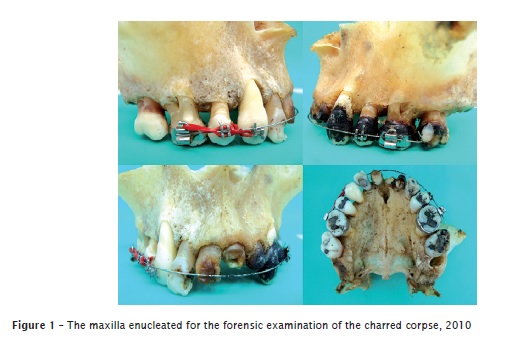
The hemisectioned mandible allowed to exam only its right side, comprising the ramus and body. All body of the mandible was carbonized, demonstrating the loss of hard tissue due to the action of fire. Also, we noted the presence of a fixed orthodontic appliance with brackets and bands, but without the orthodontic wire (figure 2).
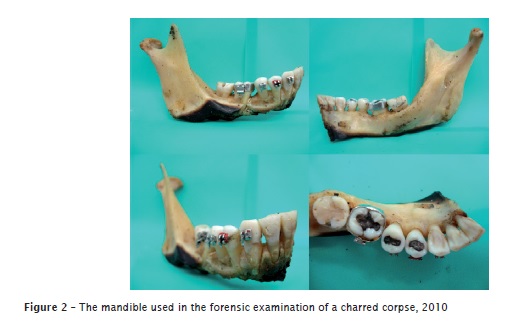
Table I displays the findings of the macroscopic examination of dental forensic analysis.
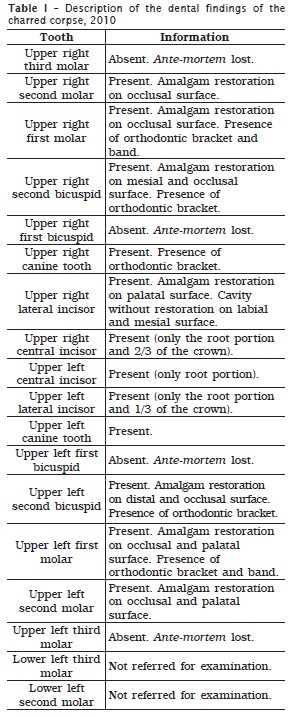
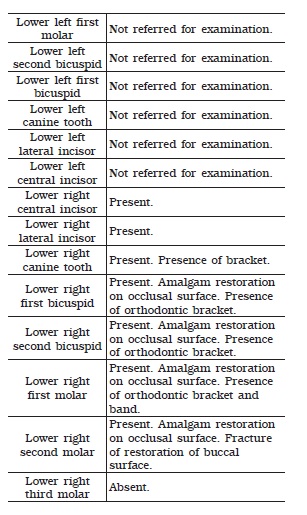
The following dental records were sent for forensic analysis: 1) lateral and frontal extra- and intraoral photographs; 2) orthodontic analysis and tracings; 3) lateral radiograph of the head; 4) panoramic radiograph; 5) periapical radiograph of the area of upper incisors; 6) periapical radiograph of lower incisors; 7) periapical radiograph of upper incisors; 8) request for dental extraction; 9) dental casts of upper and lower arches; 10) bite register wax.
Discussion
The human identification may occur through the most varied biological parameters: papiloscopic, iris, genetic, and dental analysis, among others. The choice of the methodology depends on the condition in which the body to be identified was found as well as the type of the material available for performing the comparison 13. The dental records furnished for the process of identification did not contain the register of the treatment's clinical procedures for forensic comparison. For this purpose, we use the periapical and panoramic radiographic, as well as dental casts. Concerning to the charred corpse, we perform the radiograph shot of the osseous remnants.
Among the several types of the documents produced by the clinical practice, dental files and clinical register are the most frequently ones 9, due to the necessity of recording patient's information, such as: anamnesis, dental features, and the treatment planning to be executed 10. Based on the dental information provided, we were capable of comparing them to find positive points of confrontation, to identify the individual.
By comparing the treatment performed on the upper right lateral incisor (tooth #12), we verified that its shape, contour, and site of restorative treatment was totally compatible. Also, when root and canal shape were compared, it produces a positive compatibility (figure 3). A positive comparison was also achieved in a feature of the restorative treatment of the upper right first molar (tooth #16) which presented a fracture in the palatal surface. By comparing it with the dental casts, we found the same cavity. At this same tooth, the restoration shape was matched to the dental casts (figure 4).
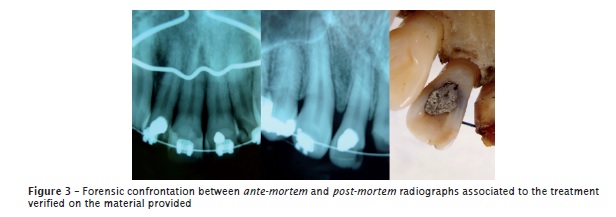

Scientific literature states that the identification of charred corpse by dental features is perfectly viable 11. For charred corpse, the most indicated technique is forensic dentistry due to the highest resistance of the teeth and restorative materials to the heat and fire action 5. Generally, forensic dentistry as well as other human identification methods comprises a comparative method. Didactically, it is divided into three stages: a) examination of the corpse's dental arches; b) examination of the dental records provided; c) forensic dentistry confrontation 8.
The examination of the corpse's dental arches should include all dental information and the dentition features, such as: restorations, presence of supernumerary teeth, absence of teeth, alterations in tooth positions, among other findings. At this first stage, the forensic expert executes complementary examinations in the body, always being guided by the dental records provided. At this moment, post-mortem radiograph examinations will be performed.
By describing tooth per tooth, as seen in table I, the forensic dentist goes to the second step of the identification process, by analyzing all the documentation provided. A new description tooth per tooth based on the documentation provided is executed. The third step is composed by the comparison of data verified in the victim with the previous findings, always using the same parameters and landmarks.
In Forensic Dentistry identification, the expert needs to pay attention in the qualitative aspects of the ante- and post-mortem information obtained, because the establishment of a positive identity and obtainment of convergent points will depend ultimately on the quality of the material to be examined 19.
Because dental forensic examination is very specialized, it demands the dental forensic expert's previous knowledge for verifying the features of each case. Therefore, the collaborative and cooperative work between Forensic Dentistry and Medicine is essential for identification cases in extreme situation, generating the results expected by the society. The scientific literature already demonstrated that Forensic Dentistry is an indispensable tool in the process of human identification and, it is capable of acting in cases of charred corpse identification, with positive results 6,15,17,21. In several cases, Forensic Dentistry is the only available method for identification.
Conclusion
By analyzing the dental records and the features found in the corpse's dental arches, convergence points were established (restoration contour, internal morphology of root canal and root shape of the upper right lateral incisor; lack of restorative treatment and restoration contour of the occlusal surface of upper right first molar) between the ante-mortem dental records and the post-mortem material provided for forensic examination, enabling the positive identification.
Acknowledges
We thank for the trust of the Center of Legal Medical Investigation of Ribeirao Preto by referring the case for identification.
References
1. Conselho Federal de Odontologia. Prontuário odontológico: uma orientação para o cumprimento da exigência contida no inciso VIII do artigo 5 do Código de Ética Odontológica. Rio de Janeiro; 2004. [ Links ]
2. Figini ARL, Silva JRL, Jobim LF, Silva M. Identificação humana. 2. ed. Campinas: Millenium; 2006.
3. Frari P, Iwashita AR, Caldas JC, Scanavin MA, Daruge Jr. E. A importância do odontolegista no processo de identificação humana de vítima de desastre em massa. Sugestão de protocolo de exame técnico-pericial. Rev Odonto. 2008;16(31):38-44.
4. Luntz L, Luntz P. Handbook for dental identification. Philadelphia: Linpincott; 1973.
5. Muller M, Berytrand MF, Quatrehomme G, Bolla M, Rocca JP. Macroscopic and microscopic aspects of incinerated teeth. J Forensic Odontostomatol. 1998;16:1-7.
6. Paranhos LR, Caldas JCF, Iwashita AR, Scanavini MA, Paschini RC. A importância do prontuário odontológico nas perícias de identificação humana. Ortodontia SPO. 2008;41(Ed. Espec.):297-301.
7. Ramos DLP, Crosato E, Mailart D. Aspectos éticos e legais da documentação radiográfica. Rev Pós-Grad. 1994;1(2):41-3.
8. Rothwell BR. Principles of dental identification. Dent Clin North Am. 2001;45:253-70.
9. Saliba CA, Moimaz SAS, Saliba NA, Soares AA. A utilização de fichas clínicas e sua importância na clínica odontológica. Rev Assoc Paul Cir Dent. 1997;51(5):440-5.
10. Silva M. Os dez mandamentos da documentação a ser realizada num consultório odontológico. Rev Assoc Bras Odontol Nac. 2000;8(1):42-4.
11. Silva RF, De La Cruz BVM, Daruge Jr. E, Daruge E, Francesquini Jr. L. La importancia de la documentación odontológica en la identificación humana. Acta Odontol Venez. 2005;43:67-74.
12. Silva RF, Pereira SDR, Mendes SDSC, Marinho DEA, Daruge Jr. E. Radiografias odontológicas: fonte de informação para a identificação humana. Odontol Clín Científ. 2006;5(3):239-42.
13. Silva RF, Portilho CDM, Reges RV, Leles CR, Freitas GC, Daruge Jr. E. Importância pericial dos registros odontológicos decorrentes de tratamento restaurador. Rev Dental Press Estet. 2007;4(4):32-8.
14. Silva RF, Ramos DIA, Pereira SDR, Daruge E, Daruge Jr. E. Modelos de gesso: importância pericial e orientações odontolegais para arquivamento. Rev Assoc Paul Cir-Dent. 2007;61(5):381-4.
15. Silva RF, Portilho CDM, Reges RV, Leles CR, Freitas GC, Daruge Jr. E. Importância pericial dos registros odontológicos decorrentes de tratamento restaurador. Rev Dental Press Estet. 2007;4(4):32-8.
16. Silva RF, Benta NG, Daruge Jr. E, Prado MM, Melo M. Importância pericial dos registros odontológicos decorrentes de tratamento protético. Rev Odontol. 2008;16(32):137-43.
17. Silva RF, Daruge Jr. E, Pereira SDR, Almeida SM, Oliveira RN. Identificação de cadáver carbonizado utilizando documentação odontológica. Rev Odonto Ciênc. 2008;23(1):90-3.
18. Silva RF, Prado MM, Barbieri AA, Daruge Jr. E. Utilização de registros odontológicos para identificação humana. RSBO. 2009;6(1):95-9.
19. Silva RF, Prado MM, Oliveira HCM, Daruge Jr. E. Quantos pontos de concordância são necessários para se obter uma identificação odontolegal positiva? Rev Odontol Unicid. 2009;21(1):63-8.
20. Silva RHA, Almeida-e-Silva CT, Oliveira RN. Prontuário odontológico: aspectos éticos e legais. In: Silva RHA. Orientação profissional para o cirurgião-dentista: ética e legislação. São Paulo: Santos; 2010. p. 167-86.
21. Valenzuela A, las Heras SM, Marques T, Exposito N, Bohoyo JM. The application of dental methods of identification to human burn victims in a mass disaster. Int J Legal Med. 2000;113:236-9.
22. Vanrell JP. Odontologia legal e antropologia forense. Rio de Janeiro: Guanabara Koogan; 2002.
 Correspondence:
Correspondence:
Ricardo Henrique Alves da Silva
Avenida do Café, s/n. – Monte Alegre CEP 14040-904 – Ribeirão Preto – SP – Brasil
E-mail: ricardohenrique@usp.br
Received for publication: October 6, 2010
Accepted for publication: November 22, 2010













